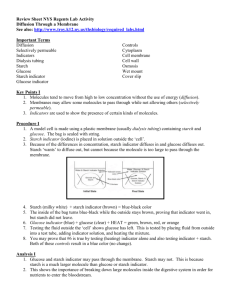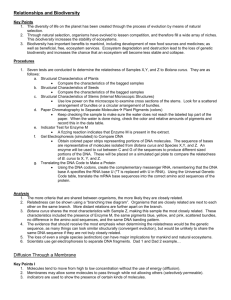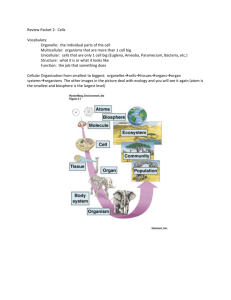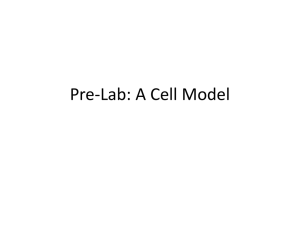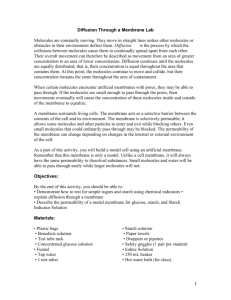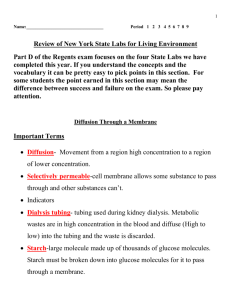Diffusion & Osmosis Lab: Membrane Permeability Summary
advertisement
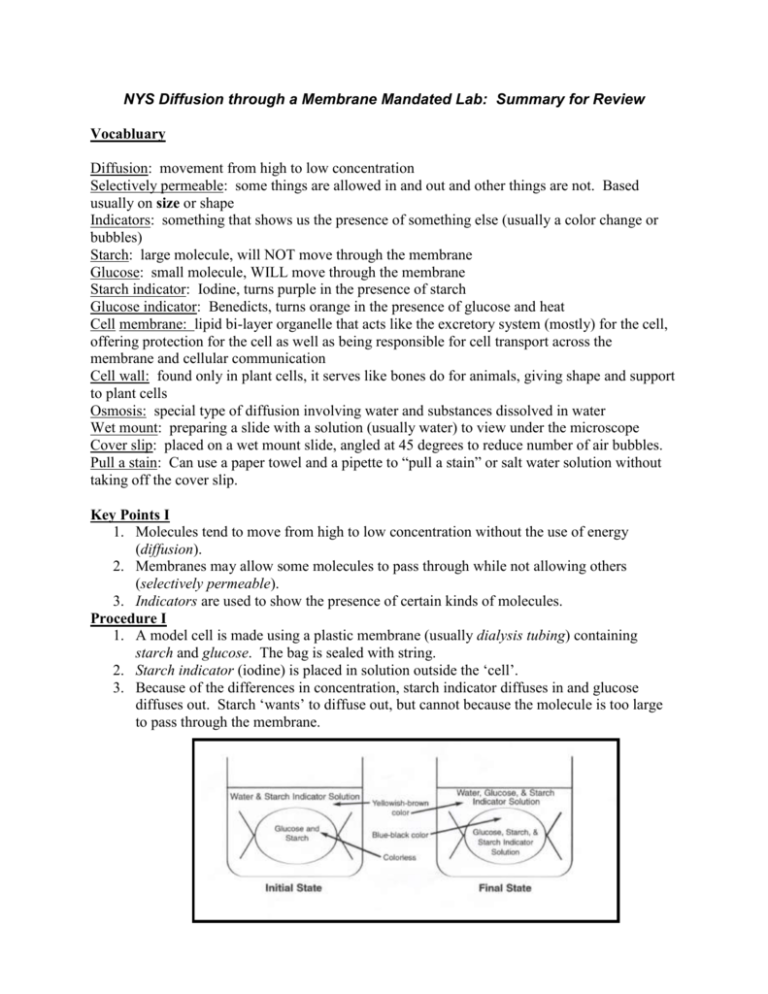
NYS Diffusion through a Membrane Mandated Lab: Summary for Review Vocabluary Diffusion: movement from high to low concentration Selectively permeable: some things are allowed in and out and other things are not. Based usually on size or shape Indicators: something that shows us the presence of something else (usually a color change or bubbles) Starch: large molecule, will NOT move through the membrane Glucose: small molecule, WILL move through the membrane Starch indicator: Iodine, turns purple in the presence of starch Glucose indicator: Benedicts, turns orange in the presence of glucose and heat Cell membrane: lipid bi-layer organelle that acts like the excretory system (mostly) for the cell, offering protection for the cell as well as being responsible for cell transport across the membrane and cellular communication Cell wall: found only in plant cells, it serves like bones do for animals, giving shape and support to plant cells Osmosis: special type of diffusion involving water and substances dissolved in water Wet mount: preparing a slide with a solution (usually water) to view under the microscope Cover slip: placed on a wet mount slide, angled at 45 degrees to reduce number of air bubbles. Pull a stain: Can use a paper towel and a pipette to “pull a stain” or salt water solution without taking off the cover slip. Key Points I 1. Molecules tend to move from high to low concentration without the use of energy (diffusion). 2. Membranes may allow some molecules to pass through while not allowing others (selectively permeable). 3. Indicators are used to show the presence of certain kinds of molecules. Procedure I 1. A model cell is made using a plastic membrane (usually dialysis tubing) containing starch and glucose. The bag is sealed with string. 2. Starch indicator (iodine) is placed in solution outside the ‘cell’. 3. Because of the differences in concentration, starch indicator diffuses in and glucose diffuses out. Starch ‘wants’ to diffuse out, but cannot because the molecule is too large to pass through the membrane. 4. Starch (milky white) + starch indicator (yellow or amber) = blue-black color 5. The inside of the bag turns blue-black while the outside stays yellow-brown (amber), proving that indicator went in, but starch did not leave. 6. Glucose indicator (blue) + glucose (clear) + HEAT = green, brown, red, or orange 7. Testing the fluid outside the ‘cell’ shows glucose has left. This is tested by placing fluid from outside into a test tube, adding indicator solution, and heating the mixture. 8. You may prove that #6 is true by testing (heating) indicator alone and also testing indicator + starch. Both of these controls result in a blue color (no change). Analysis I 1. Glucose and starch indicator may pass through the membrane. Starch may not. This is because starch is a much larger molecule than glucose or starch indicator. Water may also move based on its small size. We have evidence of this by taking the mass of the tubing before and after the experiment. 2. This shows the importance of breaking down large molecules inside the digestive system in order for nutrients to enter the bloodstream. Key Points II 1. Basic parts of the cell that are easily seen under the microscope are the cytoplasm, cell membrane, and cell wall (in plants). 2. Molecules tend to move from high to low concentration without the use of energy (diffusion). 3. Diffusion of water molecules is particularly important and has the special name of osmosis. 4. The balance of water molecules inside and outside the cell is extremely important for the survival of all organisms, including humans. Procedure II 1. Make a wet mount slide of a thin section of red onion cells. The cells are taken from the outer ‘skin’ of the onion bulb and a small piece is placed in a drop of water on a microscope slide. A cover slip is placed on top by touching it to the water at an angle, and then carefully placing it on the specimen, trying not to get air bubbles underneath. 2. The cells are examined under the light (compound) microscope. You should be able to identify the cytoplasm, cell membrane, and cell wall. 3. It is important to see that the cell membrane and cytoplasm completely fill the space within the cell wall. 4. Place a 10% salt solution under the cover slip. This is done by putting a drop of salt solution next to one edge of the cover slip, then absorbing water from the opposite side of the slip using a paper towel. 5. Observe the cells in the salt solution. It is important to see that the cytoplasm and cell membrane have shriveled up inside the cell wall. This is due to water molecules leaving the cell and entering the salty (low water) solution. 6. Place distilled water under the cover slip using the technique described in #4 above. 7. Observe the cells in distilled water. It is important to see that the cytoplasm and cell membrane have swollen back to fill the entire space available within the cell wall. Analysis II 1. Cells placed in very salty solutions will lose water, causing them to collapse and possibly lose the ability to complete life functions. 2. Cells placed in very watery solutions will tend to gain water, which causes them to swell and might cause them to burst/break open, destroying the cell (lysis). Note that this did not happen in the plant cells because the cell wall prevents the cell membrane from easily expanding. 3. Freshwater creatures, particularly single-celled organisms, must cope with too much water entering the cells. Saltwater organisms tend to have the opposite problem and must try to reclaim lost water.
